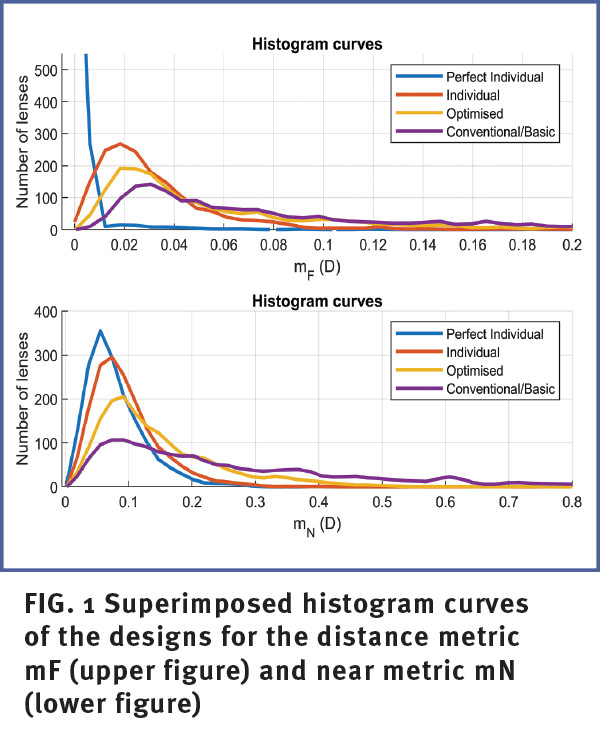Sponsored by IOT
By Deborah Kotob, ABOM
Are you among those who wondered if individual free-form progressive lens (PAL) designs are discernibly better than conventional designs or optimized free-form designs that use default values? Have you wondered what effect position of wear measurement errors have on these complex PAL designs?
Individual free-form designs are the top tier of PAL designs that compensate for actual position of wear (POW) metrics. But getting these measurements precise isn’t an exact science. While we are very good at measuring naso-pupillary distances, we are less able to produce repeatability when measuring the position of wear parameters. Unfortunately, whether we employ a sophisticated tablet app or manual measurements, we can’t control slight changes in the patient’s head posture when repeating POW measurements.
IOT scientists conducted a study to answer the question, “How much do these measurement errors affect the lens design? In other words, how large is the optical degradation from the ‘perfect individual design’ to the ‘individual design’ and then to the ‘optimized’ and ‘conventional/basic’ designs? The aim of this study was to theoretically quantify the optical degradation of four progressive designs, that is, conventional, optimized, individual and the perfect individual design.” (Pascual E, Gomez-Pedrero, JA, Alonso J. Theoretical performance of progressive addition lenses with poorly measured individual parameters. Ophthalmic Physiol Opt. 2023;43:244–253. doi.org/10.1111/opo.13088)
The study defines the four designs as follows:
- Conventional/basic: A PAL in which the back surface blends the patient’s prescription with a progressive design front surface.
- Optimized: PAL design based on ray tracing of the lens eye system and minimization of oblique aberrations assuming a fixed position of wear, with values of 8 degrees, 5 degrees and 12 mm for pantoscopic angle, wrap angle and vertex distance, respectively.
- Individual: A PAL calculated considering ray tracing of the lens-eye system, with minimization of oblique aberrations considering that the individual parameters will include some errors. These errors are uniformly distributed: ±2 degrees for tilt and ±1 mm for the vertex distance.
- Perfect individual: PAL design calculated based on ray tracing of the lens-eye system and the optimal surface to minimize oblique aberrations for the actual individual fit parameters. The perfect individual is the “state-of-the-art” PAL design that best compensates for the actual position of wear parameters; it represents the reference against which the optical quality of the other three designs is compared.
The study employed data from 1900 individual jobs to simulate the performance of four PAL designs. It confirmed that individual designs performed better than conventional and optimized PAL designs, even when POW parameters had up to ±2 degrees for tilt error and ±1 mm error for the back vertex distance.
Design performance was assessed by two metrics of optical quality, m F and m N, based on the amount of blur at the far and near reference points, respectively. A metric value of 0.25 D indicates a loss of decimal visual acuity of 0.1 in the corresponding area, which the wearer would notice as a degradation in optical performance to the perfect individual design, the results show: “…that the individual lens design has an increase of mF and mN of 0.03 and 0.02 D respectively, compared with the perfect individual design. However, this increase in the average metric does not have a noticeable impact on visual acuity. Furthermore, few users would notice a drop in visual acuity in the distance area, and only 2 percent of the users would notice a loss of visual acuity of 0.1 (decimal) at the NRP…” (Pascual E, Gomez-Pedrero et al.)
The study found that optimized designs have an increase of 0.06D in mF and a 0.07D increase in mN. But as stated by the researchers: 13 percent of wearers would notice a loss of optical performance at near and 2 percent at far.

This study showed an even greater reduction in optical performance for the conventional design. Nearly 41 percent of users notice some visual acuity loss at near and 7 percent at a distance. As illustrated in Fig. 1, the conventional PAL shows a decline in design performance. The study authors explain that “…there is no ray-trace optimization or minimization of oblique aberrations, which will vary markedly with the prescription and base curve. Accordingly, this design is expected to underperform severely in cases of moderate/high prescriptions and flat base curves, which account for most of the lenses.” This data shows that proper lens optimization that considers POW delivers, on average, better visual quality, even if the POW parameter are fixed to a default value. Furthermore, quality is further improved when the POW parameters are measured, even considering the existence of measurement errors.
Please read the study in its entirety at onlinelibrary.wiley.com/doi/10.1111/opo.13088.












